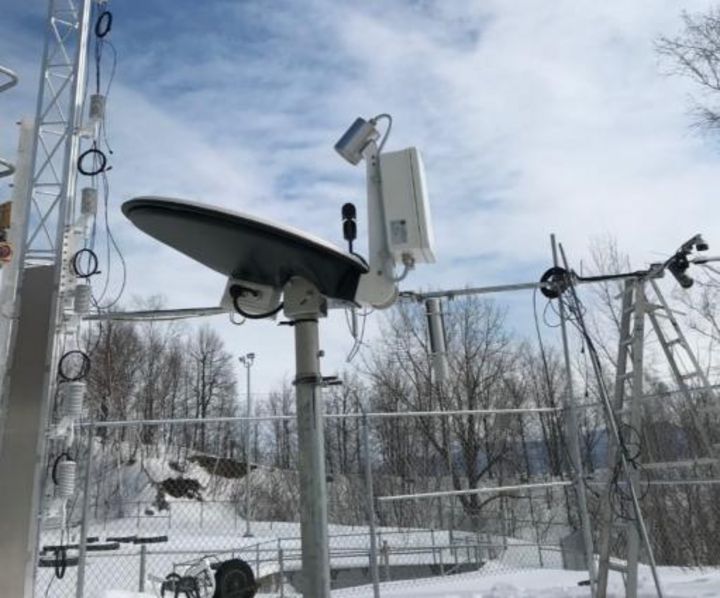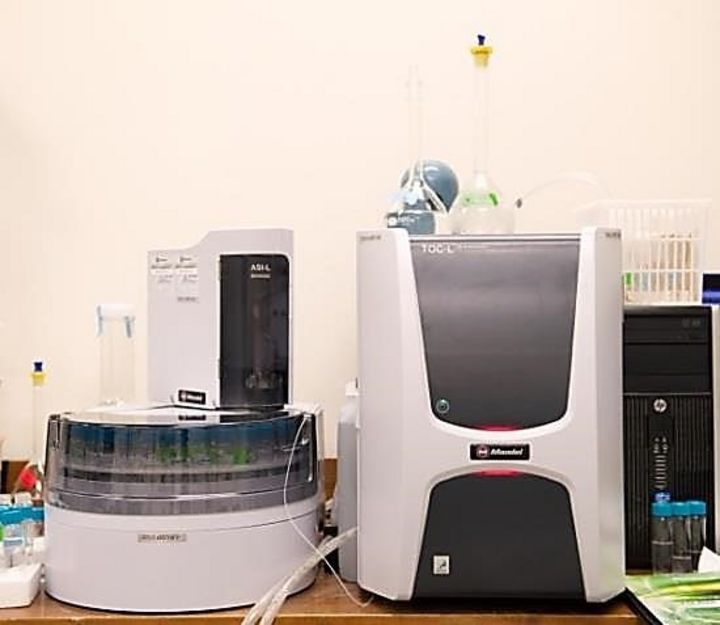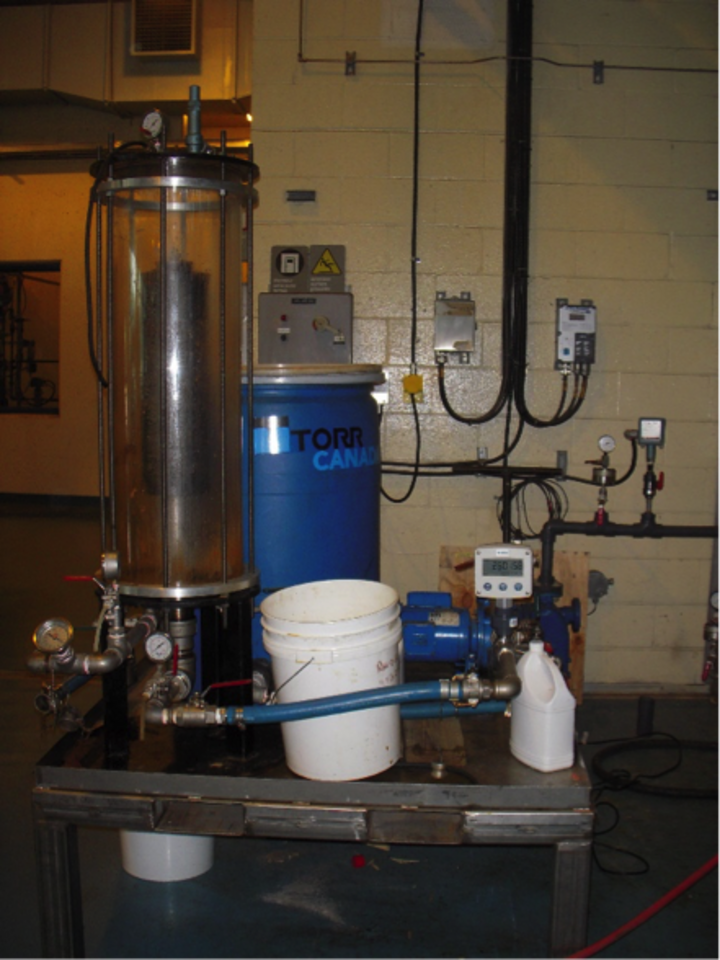
The Earth Observation System (EOS) provides the infrastructure needed to study and document ecosystems in the St. Lawrence River Valley (VFSL) in Quebec in order to develop a quantitative predictive model of system-wide interactions in the geobiosphère-climate of the region. A key aspect of EOS is its ability to include a combination of fixed facilities and a flexible mobile infrastructure to observe and analyze the Dynamic Terrestrial System (DES) in remote areas of Quebec. The VFSL climate is characterized by exceptional weather conditions (eg, ice storms), varied uses of land (urban, natural, etc.) and biodiversity flows (species loss and invasion).

- Atomic absorption spectrophotometer (flame and graphite furnace)
- Automated titrator and Karl Fisher
- Capillary electrophoresis
- Differential Scanning Calorimeter (DSC)
- Fluorescence Spectrometer X (XRF)
- FTIR infrared spectrometer with cell specialized in gas and biogas analysis
- Fluorimeter
- Gas chromatograph (GC-TCD) for gas analysis
- Gas chromatograph (GC-FID)
- FTIR Infra-Red Spectrometer For Solid And Liquid Samples
- Ion chromatography
- Gas chromatograph combined with a mass spectrometer (GC-MS)
- High-performance liquid chromatography combined with an ion-trap mass spectrometry (LC-MS)
- High-Performance Liquid Chromatography (2 Units, One Of Which Is Equipped With A Fraction Collector)
- High-Performance Liquid Chromatograph With An ELSD Detector (Electrospray Light Scattering Detector)
- Kjeldahl analyzer (total nitrogen and ammonia)
- Spectromètre d’émission optique muni d’un plasma à couplage inductif (ICP-OES)
- Thermogravimetric analyzer coupled with mass spectrometer (TGA-MS)
- Total organic carbon analyzer
The Aquatic Bio-optics and Biogeochemistry Laboratory enables researchers to study the effects of climate change and permafrost thawing on lake water transparency and mixing dynamics and their multiple impacts on the microbial food chain, greenhouse gas emissions, and oxythermal habitat. Research at the Aquatic Bio-Optics and Biogeochemistry Laboratory also focuses on developing optical equipment for early detection of algal and cyanobacterial blooms and other problems related to water browning.
The station is located 10 km north of Sacré-Coeur, near the Ste-Marguerite River, a tributary of the Saguenay. The station is used for training in hydrometry, geomorphology, ecology and research in hydrology and fish habitats. The scientific equipment includes: a weather station, a water temperature monitoring station in the Ste-Marguerite River, an ADCP measuring the flow from May to November in the Ste-Marguerite River. Users also have access to mobile ADCPs (Sontek M9 and Teledyne Streampro), electric fishermen, thermographs and turbidimeters. The facilities include a laboratory area, a chalet with a classroom for 30 people, a dormitory for 35 people, a kitchen / cafeteria and a sanitary area with showers. She is in operation from May to November. The station belongs to the Interuniversity Center for Research on Atlantic Salmon (CIRSA) and is managed by the INRS.

/// Description :
- A 55 L / min, 15 psig capacity coalescing separation vessel, SS316 stainless steel and acrylic construction with internal support for TORR ™ coalescing cartridge and safety valve
- A centrifugal type electric water pump, 220 VAC, 15 amp
- A 200-liter plastic back-up tank with removable cover for storing and recirculating water
- Set of 1 '' industrial piping, flexible for interconnection of the various elements of the system
- Set of valves for component isolation and for pump flow control
- Pressure gauges at the entry and exit of the vessel
- A 48 '' x 48 '' stainless steel table with retention walls in the event of a system leak on which all system components rest
- 10 sealing washers for replacement
- Made and assembled in Quebec
- Works with TORR ™ coalescing cartridges. Model TC-008-2, 6 '' diam x 20 '' high, nylon and nitrile gaskets
Confocal microscopy and flow cytometry laboratoryThe laboratory is equipped with a four-laser LSRFortessa cytometer that allows high-level multiparametric analyzes to characterize cell populations. A BD FACS Calibur two-laser cytometer is used to perform routine analyzes such as the expression of surface markers. The Zeiss LSM780 confocal microscopy system is a state-of-the-art instrument for the study of various cellular and subcellular biological processes such as intracellular trafficking and localization of pathogen molecules.
Processing and analysis of earth observation images in order to map and model environmental phenomena in the context of climate change. The research team in Environmental and NORdic Remote Sensing (TENOR) works on the development and application of digital approaches and the development of analysis and decision support tools applicable to various contexts by calling upon particularly in hydro-informatics, geomatics and remote sensing. The Environmental Remote Sensing by Drones (TED) laboratory includes different types of drones and a wide range of sensors: two hyperspectral cameras (400-1700 nm), a thermal infrared camera, a multispectral camera with interchangeable filters and a digital camera. The TENOR team also has a computer laboratory equipped with software specialized in image processing and geomatics, as well as field instrumentation (georadar, snow and ice corers, hydrometeorological sensors, etc.) necessary for the development and validation of algorithms.
This pilot laboratory provides the scientific community and industry with its multidisciplinary expertise and state-of-the-art equipment for the development and scaling of fermentation processes as well as the recovery, purification and characterization of various microbial derivatives. Its primary purpose is R & D in the field of biotechnology, and especially value-added products using putrescible residues as raw material.
The main objective of this project is to evaluate different final cover scenarios to reduce the production of leachate in a Saint-Nicéphore landfill, located in Drummondville, Quebec. In order to assess the percolation, the Université de Sherbrooke team proposed to build an experimental plan on the existing coverage of the site. Five lysimeters were built in 4 enclosures, that is to say areas where all the runoff water is collected in order to monitor their quantity and quality over time. The quality must be monitored due to the presence of contaminated soil in some of the scenarios under study, while the quantities are used to carry out water balances over time. This project is done in collaboration with the company Waste Management and receives financial support from WM, CRSNG and CRIBIQ.
/// Features:
- Processing volume: 1 to 4 L
- Operating pressure up to 600 psi
- Feed flow ranging from 1 L/min to 6 L/min
- Membrane coupons for MF, UF, NF, and OI
- Can be adapted to forward osmosis
/// Samples:
- Liquids: effluents, residual liquids, process waters, fluids, etc.
/// Examples of applications
- Scanning and selection of the type of membrane to be used
- Optimization of membrane filtration parameters: flow, pressure, temperature
- Studies of the effects on liquids and membranes (precipitations, clogging, pressure drop, etc.)